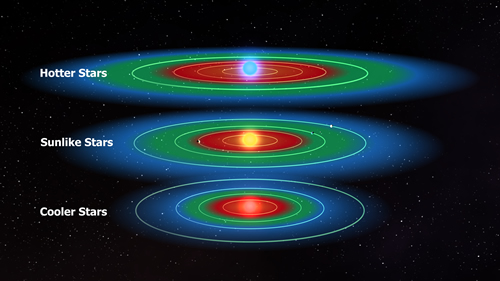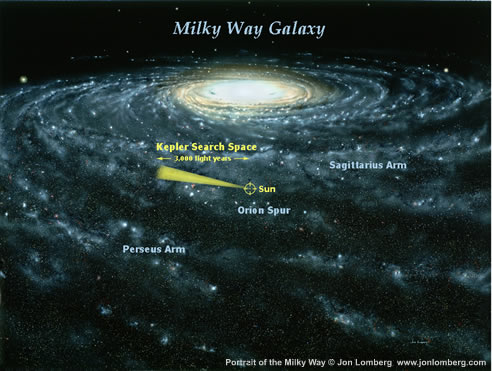With March 6 Kepler launch, work begins for Berkeley astronomers
| 03 March 2009
BERKELEY — When NASA's Kepler telescope rockets into the night sky on Friday, March 6, from Cape Canaveral Air Force Station in Florida, two University of California, Berkeley, astronomers - key members of the Kepler team - will be watching its fading contrail, hoping that the telescope will reveal Earth's and humanity's place in the universe.
 Kepler in the classroom: LHS's Alan Gould has been gearing up for years for the Kepler mission, hoping its search for habitable planets will galvanize student interest in science.
Kepler in the classroom: LHS's Alan Gould has been gearing up for years for the Kepler mission, hoping its search for habitable planets will galvanize student interest in science. Habitable planets are often said to be in the "Goldilocks zone," where it is not too hot, not too cold, but just right. This zone is far from a hot, blue star, so any habitable planet around a hot star would have a long-period orbit. For cooler, redder stars, a planet in the zone would be close-in and would orbit in several weeks or months. Short-period planets are easier for Kepler to detect because they transit their star more frequently. (Images courtesy NASA)
Habitable planets are often said to be in the "Goldilocks zone," where it is not too hot, not too cold, but just right. This zone is far from a hot, blue star, so any habitable planet around a hot star would have a long-period orbit. For cooler, redder stars, a planet in the zone would be close-in and would orbit in several weeks or months. Short-period planets are easier for Kepler to detect because they transit their star more frequently. (Images courtesy NASA)"In part, learning about other Earths - the frequency of them, the environment on them, the stability of the environment on other Earths, their habitability over the eons -- is going to teach us about our own Earth, how fragile and special it might be," said astronomy professor Geoff Marcy, a Kepler scientific advisor who, with Paul Butler and a large international planet-hunting team, have discovered nearly half of all known planets outside our solar system. "We learn a little bit about home, ironically, by studying the stars."
Gibor Basri, a UC Berkeley professor of astronomy and co-investigator for the Kepler mission, gave the mission a thumbs-up even before Marcy and others discovered the first extrasolar planet in 1995. Back then, Bill Borucki of NASA Ames Research Center in Mountain View, Calif., now principal investigator for the Kepler mission, was known for nagging astronomers to search for planets by looking for a slight decrease in a star's brightness as a planet crosses in front of the star - a so-called transit.
 Artist's rendering of the Kepler mission spacecraft and a distant solar system, highly magnified, that it is observing.
Artist's rendering of the Kepler mission spacecraft and a distant solar system, highly magnified, that it is observing.According to Marcy, who first started working on a sensitive Doppler technique for finding planets in 1984, "it was considered lunatic to look for any planets. When I first started looking, people were embarrassed for me. They would look down at their shoes and wonder why I had abandoned a perfectly good career to look for planets."
But Basri and others judged that Borucki's transit technique might just work - a conclusion bolstered by the steady stream of newly discovered exoplanets that soon began emerging from Marcy's group and a rival group led by Michel Mayor and Didier Queloz in Switzerland. However, the Doppler technique can't easily detect Earth-size planets orbiting at Earth's distance from a star. The transit technique should. Basri subsequently joined a team of astronomers with Borucki in proposing the Kepler mission, approved in 2001, to put a space-borne telescope in orbit to search for transiting Earth-like planets.
NASA is emphasizing Kepler's potential to discover new habitable rocky planets. In a media briefing held at NASA headquarters in Washington, D.C., on Feb. 19, Marcy collaborator and San Francisco State University astronomer Debra Fischer said that "the ultimate goal of NASA, in 15 years or so, it to take an image of a blue ball. Kepler will tell us how to get (to that goal)."
 This view from above the flattened disk of the Milky Way Galaxy shows the galaxy's spiral arms and the sun's modest place in the so-called Orion spur. Kepler will focus on about 100,000 stars within the galaxy to find Earth-like planets.
This view from above the flattened disk of the Milky Way Galaxy shows the galaxy's spiral arms and the sun's modest place in the so-called Orion spur. Kepler will focus on about 100,000 stars within the galaxy to find Earth-like planets.Basri will take part in a mission science briefing at Kennedy Space Center on Thursday afternoon, March 5, following a 1 p.m. EST prelaunch news conference.
Marcy expects to be kept busy by Kepler data. Kepler will focus on a single region of the sky and snap repeated images of 100,000 stars with its 95 megapixel camera, looking for stars with periodic dimming. Once Kepler team members find a candidate and determine that they're not looking at an eclipsing binary star instead, they will hand it off to Marcy and colleagues, who have reserved the Lick Observatory's three-meter telescope and the W. M. Keck Observatory' 10-meter telescopes to measure the Doppler-shifted starlight caused by the orbiting planet.
Observing from the comforts of a remote operations facility in the basement of UC Berkeley's Campbell Hall, Marcy and his colleagues should be able to determine a candidate's mass and orbit and rule out alternatives to an Earth-size planet.
Basri, who now serves as UC Berkeley's vice chancellor for equity and inclusion, is standing by in case questions arise about whether stellar dimming is the result of the star's inherent variability rather than a planet transit. Basri is an expert on star formation and active stars, and discovered the first young brown dwarf - a hot but failed star - in 1995. He, with UC Berkeley postdoctoral researcher Lucianne Walkowicz, will be trying to determine the rotation periods and activity levels of as many Kepler target stars as possible.
Within a year of launch, Borucki expects to find Earth-size planets, though these would be planets that orbit close to their star and loop around it in weeks to months. For these to be within the star's habitable zone, where the temperature is "not too hot, not too cold, but just right" to allow water to exist in liquid form, Borucki said, they would have to be orbiting smaller cooler stars such as the reddish M or K dwarfs.
By the end of the three-and-a-half-year mission, Borucki expects to find hundreds of Earth-size planets, including as many as 45 within the habitable zone of their star. Perhaps a few of these will be Earth-size rocky planets orbiting in an Earth-like orbit around a yellow G-type star like our sun - an Earth twin.
"Kepler will not find ET, but we are hoping to find ET's home," Borucki said during the media briefing. "If we do find dozens of Earth-like planets in habitable zones, life may be common throughout the galaxy."
Marcy has no doubts. "We are not the only ones; the question is really, How far away are the nearest intelligent beings? That could be a hundred light years or a million light years, we still don't know the answer to that. So Kepler is on the road, a long, long, long yellow brick road toward the Oz of habitable planets and life in the universe."

